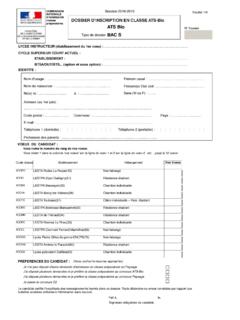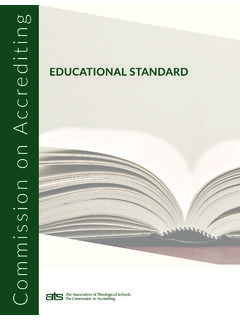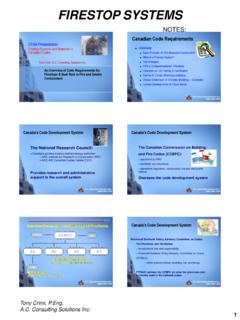Transcription of JOINT COMMISSION UPDATE 2013 - mosheonline.org
1 JOINT COMMISSION UPDATE 2013 Susan B. McLaughlinNO NEW STANDARDS..BUT NEW INTERPRETATIONS!MANIFESTS EP 11: For managing hazardous materials & waste, the hospital has the permits, licenses, manifests, and material safety data sheets required by law and regulation. DOT training for those signing JC will be looking at this Most frequent DOT findingREGULATIONS Hazardous materials regulated under the Department of Transportation (DOT) Title 49 CFR Pipeline and Hazardous Materials Safety Administration (PHMSA) RESPONSIBILITY Comply with applicable regulations Train and test employees Provide certification of training Retain records for each hazmat employee Period of employment + 90 days thereafterINITIAL TRAINING Upon new hire or job change Completion required within 90 days of hire or assignment Until completion.
2 Must work under supervision of a hazmat employee who has been properly trainedRECURRENT TRAINING Every 3 years from date of first trainingTOPICS General awareness Function-specific training Safety Security awareness Driver training if motor vehicle operator OSHA, EPA, etc. trainingTRAINING SOURCES Hazmat employer Public or private sources DOT CD @ $25 Hazardous waste haulers In-house, based on regulationsMEDICAL GAS CYLINDERS EP 1 (Fire Risk) Storage in appropriate area >12 E cylinders open to egress corridor Empty & full must be racked separatelyMEDICAL GAS CYLINDERS EP 1 (Unsafe Condition)
3 Unsecured cylinders Improper locations for transfillingMEDICAL EQUIPMENT DEPARTMENT LEADER Inventory creation Maintenance strategies Evaluate process Evaluate effectiveness MAINTAINERS Understanding of maintenance process & strategies Competencies, based on repeat work orders Work scheduled vs. work completedMEDICAL EQUIPMENT STAFF INTERVIEW Evaluate equipment reliability Evaluate response process & time Appropriate staff training on equipment use Customer satisfaction with department CONTRACT SERVICES Evaluate reliability of equipment serviced Evaluate integration of the processMONITORING, REPORTING & INVESTIGATING EP 1-11 Surveyors will be trained on this in January Look at reports into EOC Injuries to patients or others Occupational illness & injuries Security incidents Hazmat spills & exposures Fire safety problems, deficiencies.
4 Failures Medical equipment problems, failures, user errors Utilities problems, failures, user errorsEMERGENCY MANAGEMENT Discuss recent exercise or event Identify lessons learned Trace identified opportunities for improvement EOP adjustments Most frequent findings: emergency credentialingINTRACYCLE MONITORING(formerly PPR)ICM Improve PPR process Identify and proactively manage risk In pilot studies: 100% improvement over PPR 100% easy to use Will begin January 2013 Same reporting options as PPRRISK ICON Notes EP in three risk-focused categories NPSG Accreditation program specific risks Selected direct & indirect EP s On focused survey assessment tool will also identify previous RFI s in current cycleEC : Safety Officer2: Intervention Authority3: Safety Mgmt.
5 Plan5: Hazmat Mgmt. Plan7: Med Equipt. Mgmt. Plan8: Utility Mgmt. Plan : Action on risks8: Security sensitive areas : Spills & exposures7: Hazardous energy sources10: Monitoring gases & vaporsEC : Potential for harm : Visual & audible alarms11: Fire pumps under flow19: AHU shutdown by smoke detection : Input from operators & servicers2: Med equipment inventory3: Written maintenance procedures4: Written frequencies5: SMDA6: Written failure procedures & emergency clinical interventionsEC : Performance & safety checks2: Life support3: Non-life support4: Sterilizers5: Dialysis water testing.
6 Airborne contaminants : Areas where loss of power could result in patient harm : Life support4: Infection Control5: Non-life supportEC : Generator testing5: Nameplate/load bank6: ATS testing7: Triennial 4 hour test8: 30% on triennial : Testing med gas : No offensive odors :3: Action based on PCRA : Monitoring, reporting, investigating15: Annual evaluationsEM : Implement procedures in response to emergencies : Identification of volunteer LIPs : Identification of volunteer non-LIPsLS : e-SOC3: PFI time frames : Fire watch & FD notification3: ILSM policy4: Exit inspections daily5: Temporary alarm & detection : Patient sleeping room doors not locked : Fire alarm transmission : Approved sprinkler system2: Fire alarm connected to water flowsINTEGRATED SURVEY PROCESSPROCESS Surveyors have blended expertise JC & ISO Evaluate JC standards compliance Evaluate ISO 9001.
7 2008 conformance Will include Intracyclemonitoring FSA for JC standards Intracyclesurveillance audit for ISO Triennial survey JC & ISO May be available in 2013 (TBD)HOT TOPICSEYE WASH STATIONS OSHA recommended locations: Medical services and first aid caustic & corrosive Formaldehyde (as low as ) Battery charging or changing Opening caps Staff must know location & use Risk assessmentSURGICAL SITE FIRES LS surveyors gown & survey Surgical site fire plan Surgical site fire drills Alarm procedures Rescue techniques Shut off locations Staff training Observation of best practice Include surgical site fire response in time outCLINICAL ALARMS Formerly a NPSG.
8 Could return Silenced alarms Inadequate staffing to monitor/respond Alarm fatigue Patient deathsCLINICAL ALARM CITATIONS : Equipment Management EP 2: Inventory EP 3: Maintenance, inspection, testing : Equipment Reliability EP 2: Life support EP 3: Non-life support : Monitoring & Reporting EP 1: Monitoring problems & failuresPROPOSED 2014 NPSG Improve the safety of clinical alarm systems Individual alarms difficult to detect Numerous alarms Staff desensitization Disabling alarms Defaults not at actionable level Alarm limits too narrow Focus on alarms with most direct impact on patient safetyPROPOSED 2014 NPSG establishment of alarm safety as inventory of alarms and identification of default most important alarms to managePROPOSED 2014 NPSG and procedures for alarm management.
9 Necessity of specific alarms When disabling alarms is appropriate When parameters can be changed Authority for these changes Monitoring & response to alarms Checking for settings, operation, EducationRISK ASSESSMENT EP 1 Category A Risk Assessment process Quality of the process EP 3 Response to identified risk EC News, March 2013 RISK ASSESSMENT the issue Frame as yes/no supporting opposing with all a conclusion Accept or mitigate riskRISK ASSESSMENT the process report to EOC Committee Policy change(s) and reassess Define monitoring strategy Set follow-up dateEither terminate process or reassess if necessaryLIFE SAFETY DRAWINGS Must be current Suite designations Suite sizes Patient rooms used for storage Surveyors assess as shown on drawings Legend identifies features Areas fully sprinkled (if partial)
10 LIFE SAFETY DRAWINGS Hazardous storage areas Fire-rated barriers Smoke barriers Smoke compartments Chutes and shafts Extinguishers & exit signs Location of equivalencies or waiversSPECIAL LOCKING ARRANGEMENTS Clinical needs of the patients Delayed Egress NFPA 101(2000): Alarm & release in (15-30) seconds Must be manually reset Access-Controlled Egress: Sensor detects approach Manual release within 5 feetMOTHER/BABY UNITS SOME, BUT NOT ALL AHJ S WILL PERMIT: Management process Master release at nurse station Push to exit buttons Key or badge control All staff have keys or badgesPRESSURE DIFFERENTIALS POSITIVE ORs and C-section delivery rooms Sterile Processing clean workroom & sterile storage All sterile storage areas (OR sterile core & any other areas for storage of sterile supplies)







